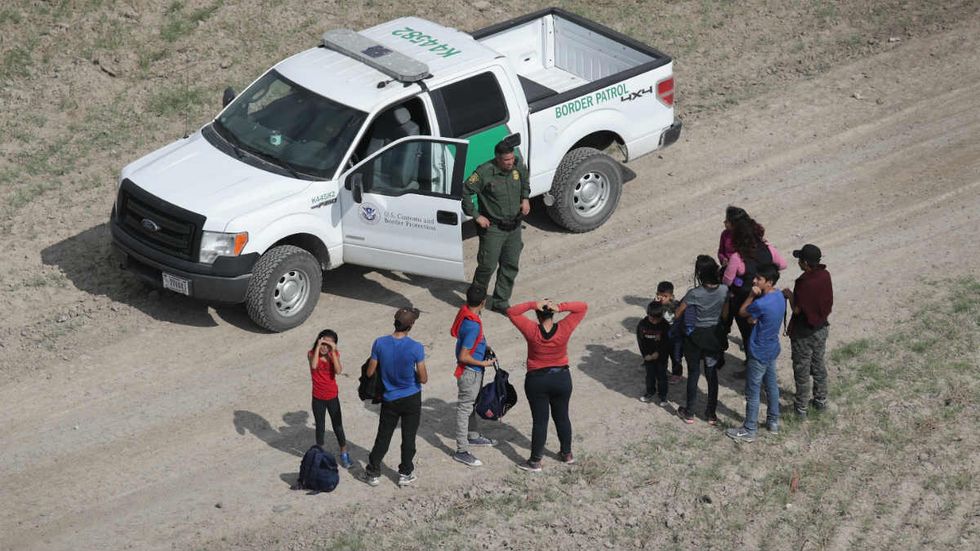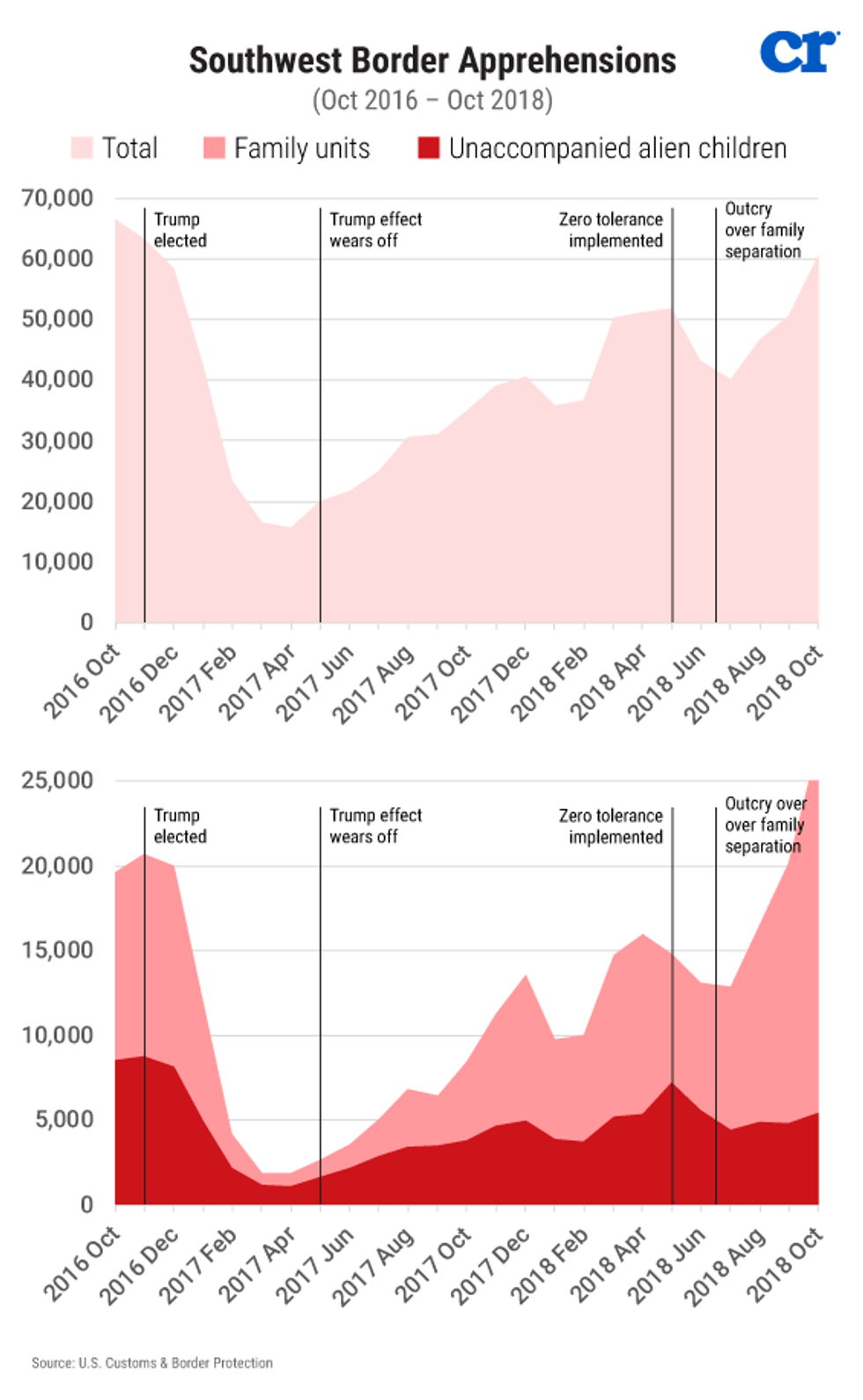
© 2025 Blaze Media LLC. All rights reserved.
Record border crossings in October. What is the administration doing?
November 13, 2018
Just when we thought the border invasion couldn’t get any worse, we set a new record in October for border crossings of family units. In September, a total of 16,658 family units were caught entering between the points of entry, an all-time record. New data from Customs and Border Patrol show that this number increased 39 percent to 23,121 in October. Given that the numbers have increased among those coming here with children, this should put to rest once and for all any myth that migration is due to “push” factors in Central America rather than judicial and executive amnesty “pull” factors in America.
Overall, in October, 50,957 individuals were apprehended at the southern border between points of entry, while another 9,770 were apprehended at the points of entry. The 60,745 total is the highest single-month total of Trump’s presidency. I believe this is only the fourth time since the Great Recession that the monthly apprehensions topped 60,000. While the number of unaccompanied teenagers has remained relatively steady after the initial rise last year, the number of family units apprehended skyrocketed by almost 2,000 percent since the rock-bottom numbers of the Trump effect in the spring of 2017. That is all because of the catch-and-release policies of the Left and the courts, yet Republicans did not make this the top issue of the campaign.
One trend that is particularly disturbing is the 600 percent increase in apprehensions in the El Paso sector, which, until now, has been dormant. While the Rio Grande sector remains the busiest corridor, and while other sectors, such as San Diego, Tucson, and Yuma, have seen large increases in apprehensions, El Paso is the hottest trafficking spot in recent months. This is very concerning because Middle Eastern immigrants have been known to cross this part of the border, and the influx of bogus asylum-seekers that is now occupying the Border Patrol in the region will strategically distract them from interdicting some of the more problematic migrants.
One other interesting trend from the CBP data is that the lion’s share of both unaccompanied teenagers and family units are from Guatemala and, to a lesser extent, from Honduras. Family or UAC migration from El Salvador has dropped sharply, as has migration from Mexico. This is a complete refutation of those who say the migrants are fleeing violence, because Guatemala is, by far, the least violent of these countries, and homicide rates are plummeting, while El Salvador is the most violent country in Central America. Also, violence in Mexico is increasing every year, yet migration is down. Hence, there’s an inverse relationship between migration and violence.
So, what is the Trump administration doing about our uncontrolled border?
Last week, the administration took my advice and invoked the president’s broad powers to shut down all forms of immigration, including refugees and asylum, under 212(f) and 215(a) of the Immigration and Nationality Act. The problem is that while the president invoked the statute that would justify a broad shutdown, he used it to implement a relatively narrow policy that doesn’t shut down our border. Rather than shutting down all border migration and requiring any asylum seeker to apply in our consulates in Mexico, which is designated as a safe third-party country by the U.N., the Trump administration is explicitly inviting all of them to apply at our points of entry. As we’ve clearly seen from the past two years, whenever you invite in illegal immigrants, they will come in droves.
To be fair, there is a clear benefit to at least shutting down asylum to those who come in between the points of entry. As noted above, having hordes of bogus asylum seekers come in through the smuggling routes empowers the drug and human smuggling cartels, is more likely to bring in dangerous people, and drains the resources of the Border Patrol.
However, Jessica Vaughan, director of policy studies at the Center for Immigration Studies, expressed her concern to me that this order would not dissuade cross-border migration even between the points of entry, much less at the points of entry:
This new rule is a pretty lukewarm response to the festering problem of hundreds of faux asylum seekers crashing the border daily, which will turn into a real crisis when the caravan of thousands arrives. Granted, it could make it a little harder for illegal entrants who might be covered under a potential proclamation barring them from entry, but even these entrants still will have asylum-like loopholes to exploit, including the form of relief known as withholding of removal, which is like asylum, but with a somewhat higher standard to pass the initial screening.
In other words, the entire point of using 212(f) should be to shut down all border migration and refuse to process anyone until the crisis subsides. Vaughan does not see the administration doing that. And given that detention facilities are already at record capacity, if we continue processing them rather than blocking their entry by force altogether, they will just be released.
Moreover, the points of entry are a huge loophole. Let’s not forget that the caravans always come to the points of entry anyway, and an increasing number of the more low-key migrants are surrendering themselves at the points of entry as well. Vaughan tells me:
The new rule is another giant invitation on a silver platter for arriving migrants to ask for asylum at the legal ports of entry, where they will be processed and released in somewhat slower motion, under the same standards that have been in place all along, which result in 90 percent of those asking for asylum being allowed to enter – despite the fact that only about 10 percent ultimately will be given asylum by a judge.
The problem is that the administration seems to be following the philosophy of DHS Secretary Nielsen – that somehow illegals have a right to enter, although they should do so in a controlled fashion. Again, there is merit to trying to demagnetize the border between the points of entry, but why have any illegal immigration once we know none of them are legitimate asylum seekers? “The biggest problem with the rule is that it is a surrender to the open-borders doctrine that the United States is somehow obligated to allow entry to almost anyone who shows up on our doorstep, legally or otherwise, who says they fear return, even if the claim is likely to be bogus,” said Vaughan.
Either we are a sovereign nation or not. And if the administration plans to go broad with its legal justification, it should go broad with the actual policy.
With illegal immigration skyrocketing, legal immigration continuing to soar, and the courts continuing to shut down our interior (and border) enforcement with no pushback from the other branches, one has to wonder if we lost an election all for nothing.
#mc_embed_signup{background:#fff; clear:left; font:14px;}
/* Add your own MailChimp form style overrides in your site stylesheet or in this style block.
We recommend moving this block and the preceding CSS link to the HEAD of your HTML file. */
Want to leave a tip?
We answer to you. Help keep our content free of advertisers and big tech censorship by leaving a tip today.
Want to join the conversation?
Already a subscriber?
Blaze Podcast Host
Daniel Horowitz is the host of “Conservative Review with Daniel Horowitz” and a senior editor for Blaze News.
RMConservative
Daniel Horowitz
Blaze Podcast Host
Daniel Horowitz is the host of “Conservative Review with Daniel Horowitz” and a senior editor for Blaze News.
@RMConservative →more stories
Sign up for the Blaze newsletter
By signing up, you agree to our Privacy Policy and Terms of Use, and agree to receive content that may sometimes include advertisements. You may opt out at any time.
© 2025 Blaze Media LLC. All rights reserved.
Get the stories that matter most delivered directly to your inbox.
By signing up, you agree to our Privacy Policy and Terms of Use, and agree to receive content that may sometimes include advertisements. You may opt out at any time.




